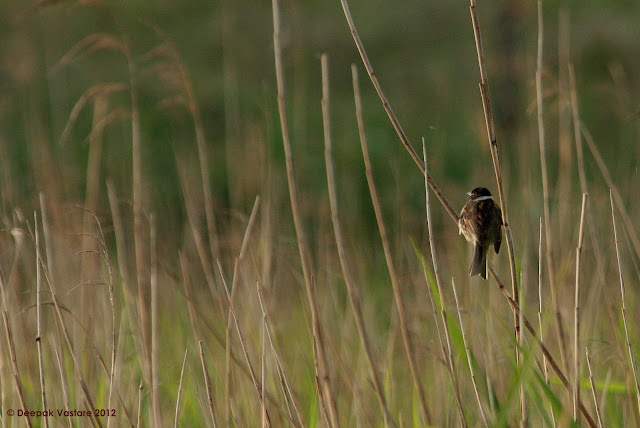 |
| A Common Gull in flight - Truly the most common one here |
 |
| Mute Swan - Mother with chicks |
 |
| Eurasian Magpie |
 |
| White Wagtail - Juvenile |
The weather was fluctuating quite a bit, from being sunny to heavy showers and with cold breeze, esp since it was the coast. And that being mid-summer day, was the longest day of the year, with the sun setting at about midnight and rising again by 3 am!
The Black headed Gulls and Greylag Geese were in huge flocks of a few hundreds, breeding. Apparently, these gulls shoo away any predators coming near the water, safeguarding their own chicks and in turn safe guarding the goose chicks too!
 |
| Reed Bunting in the midst of some reed |
The Black headed Gulls and Greylag Geese were in huge flocks of a few hundreds, breeding. Apparently, these gulls shoo away any predators coming near the water, safeguarding their own chicks and in turn safe guarding the goose chicks too!
 |
| A pair of Black Headed Gulls in morning light; shot at about 6 am |
 |
| A lone Greylag Goose |
I must say, it was a great experience for both of us. With spotting scopes taken from VOF, we were also able to sit in the guest house and just observe hundreds of birds in front of us, when we could not venture out. It was birding the European way!
 |
| Pied Avocets from far off - Loved the pied pattern against the background |
 |
| Northern Wheatear - We seem to strike luck with Wheatears! |
 |
| Tree Sparrow - A pretty common one |
 |
| Lesser Black Backed Gulls - One with a prey and the other chasing |
 |
| Eurasian Black Bird - With a melodious call |
 |
| Green Finch |
Saving the Kids…
As we were scoping around the shores, saw two Hooded Crows trying to attack the goose chicks, the mother was trying to scare the crows away with loud call. A huge black backed gull who was making his routine sortie for the food saw this opportunity and suddenly attacked the chicks. It was the lonely mother against three predators who successfully rescued the chicks by keeping the predators engaged for a while when the kids rushed back to their safe shores..
As we were scoping around the shores, saw two Hooded Crows trying to attack the goose chicks, the mother was trying to scare the crows away with loud call. A huge black backed gull who was making his routine sortie for the food saw this opportunity and suddenly attacked the chicks. It was the lonely mother against three predators who successfully rescued the chicks by keeping the predators engaged for a while when the kids rushed back to their safe shores..
Hiding under Mom….
 |
| Chicks going under mom's safe wings |
May be it was an alarm call or mother noticed us, the chicks took shelter under mothers hood.
Waders in Winter and Breeding Plumage
 |
| Ruff Duo - Males in Breeding plumage! (Shot from a long distance, but couldn't resist posting b'coz of their breeding plumage) |
It was amazing to see some of the waders that we saw back in Point Calimere, India. It was in last Oct-Nov, and they had migrated long distances, some of them even from the Arctic, for wintering in warm southern India. They were in their dull, winter plumage which made it pretty difficult for us to Id too. And now here we were, in their breeding ground, where they’re in more colorful breeding plumage, which made it so easy for us to identify from one another.
Here goes the bird list…
Gull, Common
Gull, Lesser Black Backed
Gull, Great Black Backed
Gull, Herrings
Gull, Black headed
Tern, Little
Goose, Graylag
Mallard
Teal
Shelduck, Common
Ducks, Tufted
Goldeneye, Common
Wigeon, Eurasian
Coot, Common
Gadwall
Swan, Mute
Crane, Eurasian
Heron, Grey
Eider, Common
Diver, Black throated
Cormorant
Harrier, Marsh
Lapwing, Northern
Oyster Catcher, Eurasian
Avocet, Pied
Sandpiper, Wood
Sandpiper, Green
Ruff – In Breeding Plumage!!
Greenshank, Common
Redshank, Common – Breeding Plumage!!
Redshank, Spotted
Curlew
Warbler, Reed
Warbler, White throat
Tit, Marsh
Tit, Bearded
Pipit, Rock
Pipit, Meadow
Finch, Green
Skylark, Eurasian
Bunting, Reed
Starling, Common
Redstart, Common
Linnet
Wheatear, Northern
Sparrow, Tree
Sparrow, House
Swallow, Barn
Magpie, Eurasian
Wagtail, White
Blackbird, Eurasian
Pigeon, Wood
Crow, Hooded
Jackdaw, Eurasian
Birding hideouts are the ones which I liked the most, hides are build at vantage points where you can sit and observe the winged beauties up close without bothering them.
 |
| UnId'ed Butterfly |
 |
| Brown Hare |
Book referred: Birds of Europe with North Africa and Middle East - Lars Johnsson
- Deepak and Sumana







They may be common birds there, but they are certainly new ones for us! I too enjoy birding in a foreign country, and I enjoyed this post very much. Thanks, Deepak and Sumana!How long will you be in Sweden?
ReplyDeleteDeepa.
Thank you Deepa,
ReplyDeleteNot too sure, may be for an year at least. Drop in when you are flying back home.
btw, some pain is removed now :-)
Waiting for this post. So you guys joined the migrants this year to their breeding grounds!Good work with the camera deepak.I saw the northern lapwing in Kaziranga during winter, now got to see it's breeding grounds as well!good flock pics! keep them coming
ReplyDeleteNice one and an interesting story about the mother and kids :-)
ReplyDeleteTHanks Chandu,
ReplyDeleteI just hope that It will keep coming :-)
Thank you Rana & Sugandhi
Loved the post. Keep 'em coming :)
ReplyDeleteThank you KD!
Delete